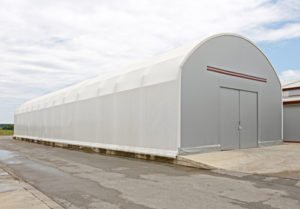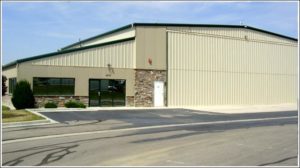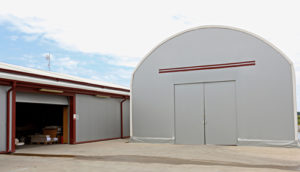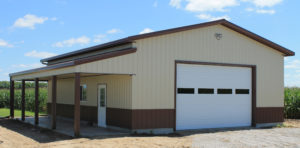
When it comes to storage solutions for businesses or even personal use, portable warehouses have become increasingly popular due to their flexibility, versatility, and, of course, portability. As with most purchases, a primary concern for most buyers is cost. In this blog post, we will delve into the costs associated with portable warehouses, the factors that influence these costs, and some tips to get the best value for your money.

Understanding Portable Warehouses
Before we break down the costs, it’s essential to understand what portable warehouses are. These structures are essentially mobile storage units that can be transported from one location to another. They are particularly useful for businesses that require temporary storage solutions, such as during peak seasons or for special projects.
Base Costs of Portable Warehouses
At its core, the price of a portable warehouse is determined by its size and basic features. As of 2023:
- Small Units (around 100-200 sq. ft.): These may range from $1,500 to $4,000. They’re perfect for personal storage or small business needs.
- Medium Units (between 200-500 sq. ft.): These typically cost between $4,000 and $10,000. This size is suitable for larger inventory storage or workshop spaces.
- Large Units (500+ sq. ft.): These can range anywhere from $10,000 to $30,000 or more, depending on customizations. Large units are often used for substantial business operations or specialized storage needs.
Factors Influencing the Cost
Several elements can affect the final price of a portable warehouse:
- Material: The cost can vary significantly based on the material used. Steel warehouses, for instance, might be more expensive than wooden or fabric ones due to their durability and strength.
- Customization: Additional features like insulation, HVAC systems, custom shelving, or security enhancements can add to the cost.
- Delivery & Installation: Depending on the vendor and your location, delivery and installation fees can be a significant part of your total expense.
- Duration of Use: If you’re renting instead of buying, the duration of your lease can influence the cost. Short-term rentals might have higher monthly rates than long-term contracts.
- Maintenance: While not an upfront cost, maintenance expenses should be factored into the total cost of ownership. Some materials or models may require more frequent maintenance than others.

Tips to Get the Best Value
- Assess Your Needs: Before making a purchase or signing a lease, evaluate your exact storage needs. Avoid overestimating or underestimating to ensure you get the right size and features.
- Comparison Shop: Different vendors will offer varying prices. Get multiple quotes to ensure you’re getting the best deal.
- Consider Used Units: If you’re on a tight budget, consider purchasing a used portable warehouse. These can be significantly cheaper than new units but ensure they’re in good condition.
- Negotiate: Whether you’re buying or renting, there’s often room for negotiation. Don’t hesitate to ask for discounts or additional perks.
- Review the Contract: If renting, read the contract thoroughly. Look out for hidden fees, maintenance clauses, and other terms that might increase your costs.
Portable warehouses offer a versatile solution for various storage needs. While their costs can vary based on size, features, and other factors, understanding these elements can help you make an informed decision. Remember, the cheapest option isn’t always the best. Prioritize quality and reliability to ensure your stored items are safe and secure.

Benefits of Investing in Portable Warehouses
As the business landscape evolves and the need for adaptable solutions grows, the appeal of portable warehouses continues to rise. Beyond the obvious advantage of mobility, there are numerous other benefits to investing in these structures. Let’s dive into the myriad of advantages they offer:
1. Flexibility
One of the most prominent benefits of portable warehouses is flexibility. Whether you’re expanding your operations, relocating, or simply need temporary additional storage space, these structures can adapt to your changing requirements. There’s no need to commit to a fixed, permanent structure when your needs might change in the near future.
2. Cost-Effective
Constructing a traditional brick-and-mortar warehouse can be costly and time-consuming. Portable warehouses, on the other hand, offer a more budget-friendly alternative. With a reduced need for ground preparation and faster setup times, businesses can save significantly on both initial investment and ongoing maintenance costs.
3. Quick Deployment
In situations where time is of the essence, such as seasonal demand spikes, portable warehouses shine. They can be quickly assembled and made operational in a fraction of the time it would take to build a permanent structure or find suitable rental space.
4. Scalability
Business needs can change, and scalability is crucial. With portable warehouses, you can easily scale up by adding more units or scale down by removing some. This modular approach allows for a dynamic response to fluctuating inventory levels or operational demands.

5. Reduced Commitment
Renting or leasing property can often come with long-term contracts or hefty penalties for early termination. Portable warehouses, especially if rented, offer a solution that reduces such commitments. This is particularly useful for businesses unsure of their long-term location or storage needs.
6. Enhanced Security
Many modern portable warehouses come equipped with robust security features. From reinforced doors to advanced locking mechanisms and integration capabilities with surveillance systems, these structures can be as secure as any permanent facility.
7. Environmentally Friendly
Portable warehouses often have a smaller carbon footprint than their traditional counterparts. Their construction requires fewer materials, and their ability to be reused or relocated means less wastage. Additionally, many manufacturers are now using eco-friendly materials and practices in their production.
8. Versatility in Use
While primarily used for storage, the versatility of portable warehouses means they can serve other purposes. They can be transformed into pop-up retail spaces, temporary offices, or even workshop areas. This multifunctionality can be especially useful for businesses operating in multiple domains.
9. Improved Cash Flow
For businesses that opt to rent portable warehouses, there’s an advantage in terms of cash flow. Instead of a large upfront capital expenditure, they can manage their finances with predictable monthly expenses. This can be beneficial for businesses looking to invest their capital in other growth areas.

The decision to invest in portable warehouses is not just about storage; it’s about equipping your business with a solution that offers flexibility, efficiency, and adaptability. In a rapidly changing market, having assets that can pivot as quickly as your business strategy can be invaluable. As with any investment, it’s essential to assess your unique needs, but for many, the benefits of portable warehouses make them an attractive proposition.

Considering the Long-Term Value of Portable Warehouses
- Economic Efficiency Over Time
While the immediate costs and benefits of portable warehouses are evident, many potential buyers or renters may question their long-term economic efficiency. How does the investment or monthly rental fee stack up over several years?
Over the years, the value of a portable warehouse doesn’t just lie in its primary function of storage. Instead, its adaptability can lead to diverse revenue streams and cost-saving strategies. Here’s how:
- Adaptation to Market Changes
The global market is anything but static. Economic downturns, rapid industry evolutions, and unforeseen global events can drastically alter a company’s operational needs. In such scenarios, the flexibility offered by portable warehouses ensures that businesses aren’t left with redundant or unnecessary infrastructure. Instead, they can quickly scale up or down, ensuring they’re only paying for what they use.
- Disaster Recovery
In regions prone to natural disasters like hurricanes, floods, or wildfires, having a mobile solution for storage and operations can be invaluable. Portable warehouses can be relocated to safer zones during high-risk periods, ensuring business continuity and reducing potential loss of goods.
- Limiting Long-Term Maintenance Costs
Traditional structures, over time, require significant maintenance, especially if constructed using materials vulnerable to the elements. Portable warehouses are often made of durable materials designed to withstand various conditions, leading to reduced long-term maintenance costs.
- Reducing the Need for Expensive Expansion
For growing businesses, expansion usually comes with hefty price tags. Instead of investing in new buildings or long-term leases on larger spaces, businesses can acquire additional portable units. This modular approach to expansion can result in massive cost savings over several years.
- Potential for Diverse Revenue Streams
Beyond just storage, these units can be repurposed for different revenue-generating activities. For instance, a business could transform a unit into a temporary retail outlet during peak seasons, or lease it to another business during off-peak periods.

The long-term value of portable warehouses goes beyond the simplicity of storage. Their multifunctional nature, combined with the dynamic landscape of global business, means they’re not just an expense but an investment. Companies that can envision their long-term needs and the changing nature of commerce will find that portable warehouses offer both adaptability and sustainability in a fluctuating market.

Portable Warehouses and Modern Technology
The intersection of portable warehousing and cutting-edge technology is reshaping the storage and logistics landscape. No longer just plain storage units, modern portable warehouses are increasingly equipped with advanced features, driven by technological advancements, to offer smarter and more efficient storage solutions.
Smart Storage Solutions
One of the main innovations in this space is the integration of smart storage systems. By using sensor technology, businesses can track the real-time status of their inventory, ensuring optimal stock levels and reducing wastage. These sensors can also provide alerts for conditions that might harm sensitive goods, like moisture or temperature fluctuations. With IoT (Internet of Things) integration, it’s possible to monitor storage conditions and inventory levels remotely, making management more efficient and less time-consuming.
Climate Control Features
The need to store temperature-sensitive items like pharmaceuticals or perishable goods has driven the demand for portable warehouses with advanced climate control. Modern units can maintain a consistent temperature, regardless of external conditions, thanks to high-tech insulation and HVAC systems. Some warehouses even offer zoned climate control, where different areas within the warehouse can be set to different temperatures. This is particularly useful for businesses that deal with a range of products requiring varying storage conditions.
Security Enhancements
The digital age has also revamped the security features available for portable warehouses. Traditional locks have been supplemented or even replaced by digital locks, which can be monitored remotely and offer features like access logs. Surveillance has also seen an upgrade. While CCTV cameras remain popular, there’s a shift towards smart cameras which can provide real-time alerts in case of breaches. Additionally, integration with modern security systems allows for features like motion detection, night vision, and even facial recognition in some high-end models.
In addition to physical security, digital security is also paramount, especially for warehouses integrated with IoT. Ensuring that these systems are protected from potential cyber-attacks is crucial, and many modern portable warehouse providers are prioritizing this with robust digital security protocols.

Technology has significantly elevated the capabilities of portable warehouses. What was once a simple storage solution has transformed into a dynamic space that can cater to the varied and intricate demands of modern businesses. From maintaining the perfect environment for goods storage to ensuring that inventory is always under watchful eyes, both physically and digitally, the modern portable warehouse stands as a testament to how technology can reshape industries.

Design and Customization Options in Portable Warehouses
In an era where adaptability and personalization are highly sought-after qualities, portable warehouses are no exception. These storage solutions offer a wide array of design and customization options that allow businesses to tailor them to their unique needs and preferences.
Flexibility in Size and Layout:
- Portable warehouses come in various sizes, from compact units suitable for small businesses to expansive spaces that can accommodate a larger inventory. Beyond just size, the internal layout can be modified to fit specific storage requirements. For instance, businesses might want shelves tailored for particular product dimensions or opt for open spaces that allow for larger equipment storage.
- While opting for a larger warehouse or a specialized internal layout can affect the overall cost, it often leads to greater efficiency and utilization of the space, potentially offering a better return on investment.
Aesthetic Modifications
- The exterior of a portable warehouse can be just as customizable as the interior. Businesses can opt for specific colors or branding elements to ensure the warehouse aligns with their brand identity.
- This is especially beneficial if the warehouse is placed in a location visible to clients or the general public. It’s worth noting that custom paint jobs or branding elements might increase the initial cost but can contribute to brand visibility and recall.
Flooring Options
- Depending on the goods stored, different flooring options might be more suitable. For heavy machinery or products, reinforced flooring might be essential. Meanwhile, perishable items might benefit from easy-to-clean and moisture-resistant flooring.
- The type of flooring can have a noticeable impact on the price; specialized flooring options tend to be more expensive than standard ones.
Advanced Features and Add-ons
- There are several advanced modifications available for portable warehouses to enhance their functionality. These can include skylights for natural lighting, advanced ventilation systems for better air circulation, or even integration points for technology like IoT sensors.
- Each of these add-ons comes with its own price tag. Businesses should weigh the benefits of these features against their cost to determine the best setup for their needs.
Windows and Access Points
- Depending on usage, additional windows or varied access points (like larger doors or multiple entry points) can be incorporated.
- For instance, if a warehouse doubles as a sales point or needs regular access for large quantities of stock, multiple or larger entry points can be invaluable. While they might marginally increase costs, the operational benefits often justify the expenditure.

The customization possibilities for portable warehouses are vast, allowing businesses to mold them into precisely what they require. While modifications can affect the initial cost of the warehouse, the long-term benefits, from brand visibility to operational efficiency, often make these investments worthwhile. When considering a portable warehouse, it’s essential to balance the immediate budget constraints with the long-term value these customizations can provide.

Safety Standards and Regulations in Portable Warehouses
The importance of safety standards and regulations cannot be overstated when it comes to portable warehouses. Given their movable nature and the potential to house valuable or sensitive goods, ensuring that these structures are safe, secure, and compliant with regulations is imperative. Let’s delve into the key safety standards that guide the manufacturing of portable warehouses and the essential checkpoints potential buyers should be aware of.
Manufacturing Standards
Manufacturers of portable warehouses have a duty to adhere to strict industry standards. These standards dictate the quality of materials used, structural integrity, fire safety, and even environmental impact. Key regulatory bodies, such as the International Building Code (IBC) or regional equivalents, set these standards. Compliance ensures that the warehouse can withstand external pressures such as wind, rain, and snow, making them robust and long-lasting.
Fire Safety
Given that portable warehouses can be used to store all manner of items, including those that are flammable, fire safety is a paramount concern. Warehouses should be constructed with fire-resistant materials and may also need integrated fire suppression systems, such as sprinklers. Additionally, the layout should promote easy evacuation, and there should be clear signage indicating exit routes.
Electrical Standards
If a portable warehouse is equipped with electrical installations, it needs to conform to established electrical safety standards. This might involve ensuring grounded installations, circuit breakers, and safe wiring protocols. Electrical systems should be inspected regularly to prevent potential fire hazards or electrical malfunctions.
Flooring and Load Bearing
Safety standards for flooring are especially critical for warehouses storing heavy equipment or goods. The flooring should be designed to bear the intended load without buckling or showing signs of stress. Additionally, slip-resistant flooring can prevent accidents, especially in areas prone to moisture.
Ventilation and Air Quality
For warehouses storing chemicals or perishables, ventilation is crucial. Proper air circulation prevents the buildup of toxic fumes or molds. Standards often dictate the minimum air change rates and the quality of filters to be used, ensuring a safe environment for both the goods and any personnel.

What Potential Buyers Should Look Out For
When in the market for a portable warehouse, potential buyers should be vigilant about the following:
- Certifications: Always ask for certifications proving that the warehouse adheres to regional and international safety standards. Reputable manufacturers will readily provide these.
- Inspections: Before finalizing a purchase or rental, consider getting the warehouse inspected by a third-party expert to verify its safety and compliance.
- Custom Modifications: If you’re looking for specific modifications, ensure they don’t compromise the warehouse’s safety. For instance, adding a larger door might impact the structure’s stability.
- User Reviews: Past users or renters can offer valuable insights into the warehouse’s safety and durability. Seek out reviews or ask the manufacturer for references.
- Warranty and Guarantees: A warranty can serve as an assurance of the warehouse’s quality and the manufacturer’s commitment to safety standards.

Safety and compliance are non-negotiable when it comes to portable warehouses. By understanding the standards and being diligent during the purchase process, businesses can ensure they invest in a safe, reliable, and compliant storage solution.
Comparison with Traditional Warehousing
The choice between a traditional warehouse and a portable one isn’t merely about space – it encompasses considerations of durability, maintenance, financial implications, and adaptability to specific business needs. Let’s dive deep into the comparisons between these two warehousing options, focusing on their strengths and potential drawbacks.
Durability
- Traditional Warehouses: Constructed using robust materials like steel, brick, or concrete, traditional warehouses are designed for long-term use. Their structures are meant to withstand diverse environmental conditions, from torrential rain and snow to extreme heat. With proper maintenance, they can last for decades.
- Portable Warehouses: While portable warehouses are designed for mobility and ease of setup, it doesn’t mean they compromise on durability. High-quality portable warehouses are constructed from durable materials, often steel or high-grade aluminum. They are designed to handle transportation stresses and are treated for weather resistance. Their lifespan might be shorter than traditional warehouses, but with care, they can serve effectively for many years.

Maintenance
- Traditional Warehouses: These structures often require regular maintenance. This includes checking the roof for leaks, maintaining large foundational structures, and tending to wear and tear on loading docks or entry points. Over time, these costs can add up, especially if the warehouse is in a region prone to environmental stresses like heavy snow or rain.
- Portable Warehouses: Maintenance is generally simpler for portable options. Due to their modular nature, damaged parts can often be replaced without major disruptions. Additionally, their smaller size often means less ground to cover during routine checks.
Total Cost of Ownership
- Traditional Warehouses: The initial investment for traditional warehouses is significant, given the cost of construction, land acquisition (if not already owned), and setting up utilities. Over time, additional costs can crop up due to maintenance, property taxes, and potential modifications or expansions.
- Portable Warehouses: One of the main attractions of portable warehouses is their cost-effectiveness. The initial outlay is typically lower than constructing a permanent structure. There are fewer property-related costs, and in some cases, they might even qualify for different tax considerations. Over the long term, despite potentially higher maintenance costs per square foot, the total cost of ownership often remains lower than traditional warehousing, especially if the business does not require long-term warehousing solutions.
Flexibility and Adaptability
- Traditional Warehouses: Once set up, these structures are permanent. While they offer stability, any required changes or expansions can be costly and time-consuming.
- Portable Warehouses: Flexibility is where portable warehouses shine. Businesses can easily relocate them, expand by adding units, or modify their internal layout without significant investments.
While traditional warehouses have their place in large, stable operations that require vast amounts of storage, portable warehouses offer a level of adaptability and cost-effectiveness that’s hard to match. For businesses that value flexibility, or for those that are still scaling and uncertain about long-term space requirements, portable warehouses present an attractive option. Each business should carefully weigh their specific needs, budget, and future plans when choosing between these two warehousing solutions.


